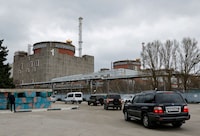The Russian-appointed governor of occupied Zaporizhzhia said Sunday that about 1,600 civilians had been moved out Enerhodar, home to the plant and many of its employees, and other communities. He cited “intensified shelling” by Ukrainian forces.
“What is most actually concerning for us is that we also have information that there are 3,100 people, workers from the Zaporizhzhia nuclear power plant, who are to be evacuated from the area,” Kotin said.
“They are preparing for this advance of Ukrainian forces. And if this happens, then they want to be prepared … to leave the area,” he said. But if the staff is evacuated, he said, “there will be lack of personnel just to operate the plant.”
The situation is becoming “unpredictable and potentially dangerous,” the head of the U.N. nuclear watchdog warned over the weekend.
“I’m extremely concerned about the very real nuclear safety and security risks facing the plant,” said Rafael Mariano Grossi, director general of the International Atomic Energy Agency, or IAEA. “We must act now to prevent the threat of a severe nuclear accident and its associated consequences for the population and the environment.”
Kotin said he learned about preparations for a staff pullout on Sunday.
Ukraine has been planning for months to launch a large-scale counteroffensive aimed at retaking territory under Russian control. Analysts believe the nuclear plant, a major source of electricity and income for Ukraine, will be a top priority.
Evgeniy Balitsky, the Russian-appointed governor of occupied Zaporizhzhia, said he had ordered the evacuation of more than a dozen settlements near the plant.
“In this regard, I decided to remove, first of all, children with their parents, the elderly, the disabled, patients of medical institutions from enemy fire and move them from the front-line territories deep into the region,” he wrote on Telegram.
About 11,000 people worked at the nuclear power plant before the war, Kotin said. Of the employees who remain, he said, about 2,700 have signed contracts with the Russian State Atomic Energy Corporation, or Rosatom. About 1,500 are still employed by Ukraine’s Energoatom.
Altogether, there are currently about 4,000 staff working at or around the plant — “the exact amount needed for operation,” Kotin said.
“If they go out and then we recapture the plant and return it under our control, then we will have challenges to … just operate the plant,” he said.
Some infrastructure at the plant requires constant supervision, he said. Eliminating that oversight “will be dangerous for the plant itself.”
He noted that Russian forces have transformed the plant into a military base that serves as a kind of shelter, because they believe Ukrainian forces are unlikely to target it.
“More and more soldiers are coming on-site and they are constantly living [there],” he said.
Grossi, of the IAEA, has been pushing Russia and Ukraine to agree to a special security zone around the plant to avoid a potentially disastrous leak of nuclear materials.
The nuclear watchdog said Saturday that its personnel assigned to the power plant had not been able to travel to Enerhodar in the previous several days. It also noted that Yuriy Chernichuk, the Russian-appointed plant site director, has said staff are not being evacuated.
A Ukrainian employee of the plant said evacuation buses are seen daily, but that “who exactly is traveling is not visible” because the windows are covered with curtains.
The employee spoke on the condition of anonymity because of security concerns.
“Ukrainian personnel are not going to evacuate,” the employee said. Those employed by Rosatom are next due to report to work after May 10, the day after Russia’s Victory Day celebrations to commemorate the end of World War II. “Then we’ll see,” the employee said.
The evacuations, Kotin said, are a sign that Russian forces are “scared and trying to be ready to get out of there.”
Kamila Hrabchuk in Dnipro, Ukraine, contributed to this report.



